
Arrhenius is a lunar impact crater that is located just on the far side of the Moon, near the southwest limb. In this location the vicinity of the crater can be viewed during favorable librations, although it is viewed from on edge. To the south-southeast is the worn crater Blanchard, and De Roy lies further to the west.

Baade is a lunar impact crater that is located near the southwest limb of the Moon on the near side, to the southwest of the enormous Mare Orientale impact basin. The area to the east of this crater forms the junction between the 280-km-long Vallis Bouvard to the north and the narrower, 160-km-long Vallis Baade to the south-southeast. Both valleys radiate away from the impact basin to the north.

Shaler is a lunar impact crater that lies on the southeast interior edge of the Montes Cordillera mountain ring that surrounds the immense Mare Orientale formation. It is located near the southwest limb of the Moon on the near side, and so is viewed nearly from on edge from the Earth. Just to the northwest of the crater is the slightly smaller crater Wright.

Blanchard is a lunar impact crater that lies on the far side of the Moon, just behind the southwestern limb. It lies to the south-southwest of the crater Arrhenius, and northwest of Pilâtre. Further to the south is the rugged terrain to the north of the walled plain Hausen.

Drude is a lunar impact crater that lies on the far side of the Moon, in the rugged Montes Cordillera range that forms the outer ring around the Mare Orientale impact basin. It is located just behind the west-southwest limb, and this area is sometimes brought into sight from Earth during favorable librations. However, even at such times, the crater is viewed from the edge and little detail can be seen.

Hausen is a large lunar impact crater that lies along the south-southwestern limb of the Moon. It was named after German astronomer Christian A. Hausen by the IAU in 1961.
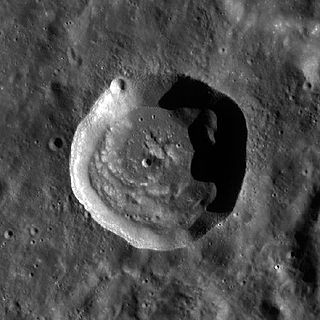
Chant is a lunar impact crater that is located on the far side of the Moon, behind the southwest limb as seen from the Earth. It lies within the southwestern part of the blanket of ejecta surrounding the Mare Orientale, beyond the Montes Cordillera mountain ring. To the west-northwest is the large walled plain Blackett. Southward is the crater Mendel.

Chadwick is a lunar impact crater that lies on the far side of the Moon's surface, just beyond the southwestern limb. It is located to the northwest of the crater De Roy, and was previously designated De Roy X before being given its current name by the IAU. This region of the lunar surface lies at the southern end of the ejecta blanket that surrounds the Mare Orientale impact basin.

Dyson is a lunar impact crater, 63 kilometers in diameter, that lies on the far side of the Moon, past the northwest limb. It is located in the northern part of the surface, to the northwest of the crater Coulomb, and east of van't Hoff.

Chaplygin is a large lunar impact crater that lies on the far side of the Moon. It is located to the southeast of the huge walled plain Mendeleev, about midway between the craters Schliemann to the northeast and Marconi to the southwest. It is about the same size as Albategnius on the near side.

Graff is a small lunar impact crater that lies along the southwestern limb of the Moon. It is located to the west of the Vallis Bouvard depression in the southern part of the ejecta blanket that surrounds the Mare Orientale impact basin. To the south-southwest is the smaller crater Catalán.
Piazzi is an impact crater that is located near the southwestern limb of the Moon, and is attached to the southeastern rim of the walled plain Lagrange. About three crater diameters to the south is the crater Inghirami. Piazzi is seen at an oblique angle from the Earth, and it appears oblong due to foreshortening.

Chappe is a lunar impact crater that lies along the southwestern limb of the Moon. It is nearly attached to the northern limb of the walled plain Hausen, and an equal distance from the crater Pilâtre. To the north-northwest is Blanchard.

Steklov is a lunar impact crater on the far side of the Moon, past the southwestern limb. It lies in the outer skirt of ejecta from the Mare Orientale impact basin, just to the southwest of the Montes Cordillera ring of mountains. About four crater diameters to the southwest is the slightly smaller crater Chant.
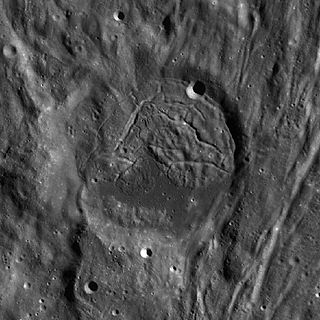
Fényi is a small lunar crater on the far side of the Moon. It lies near the southern edge of the huge, braided skirt of ejecta that surrounds the Orientale impact Basin to the north. Less than two crater diameters to the southwest is the much larger crater Mendel.
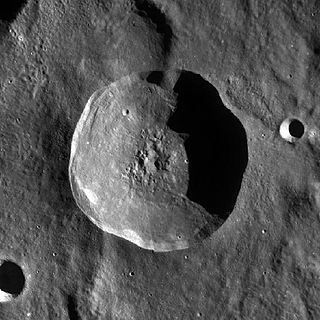
Guthnick is a lunar impact crater that lies on the far side of the Moon's surface from the Earth. However, it is located in the part of the far side that is sometimes brought into sight of the Earth due to libration, although it can only be seen at a low angle and during favorable lighting conditions. Guthnick is situated in the southern portion of the huge skirt of ejecta that surrounds the Mare Orientale impact basin. Less than a crater diameter to the northwest is the slightly larger crater Rydberg. To the south-southwest is the small Andersson.
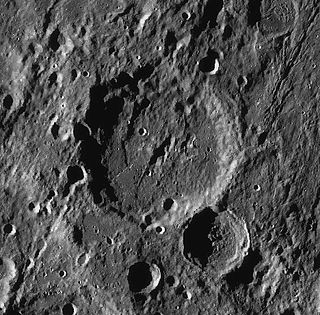
Mendel is a large Impact crater that lies on the far side of the Moon. It is located in the southern fringe of the huge skirt of ejecta that surrounds the Mare Orientale impact basin. To the south-southwest of Mendel is Lippmann, an even larger crater.

Rydberg is a lunar impact crater that is located on the far side of the Moon, just past the southwest limb. It lies due south of the Mare Orientale, in the outer skirt of ejecta that surrounds the Orientale impact feature. Just to the southeast is the crater Guthnick.
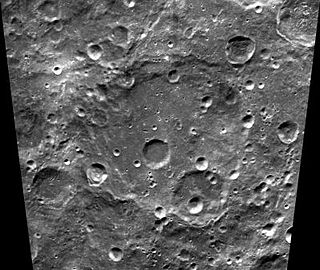
Lippmann is a large lunar impact crater in the southern part of the far side of the Moon and so cannot be viewed directly from the Earth. Just to the northeast is the walled plain Mendel, only slightly smaller than Lippmann. To the south-southeast lies the crater Petzval.

Rocca is a lunar impact crater that is located near the western limb of the Moon. It lies to the northwest of the flooded crater Crüger, and to the west of the Montes Cordillera. Just to the east-southeast of Rocca is the small Lacus Aestatis, a small lunar mare.




















